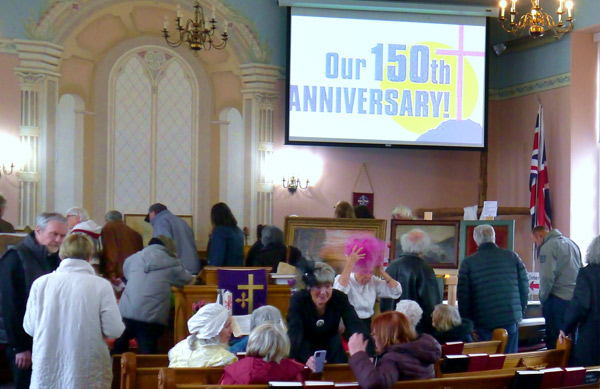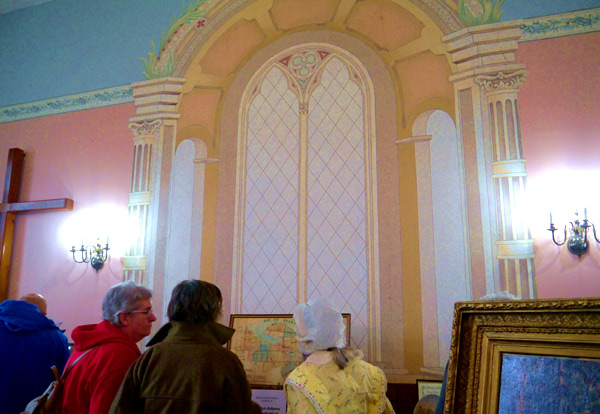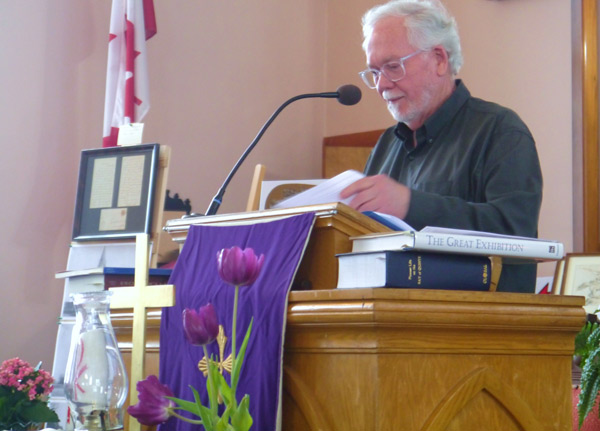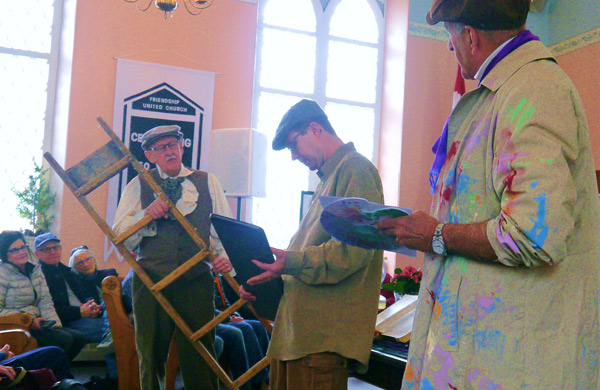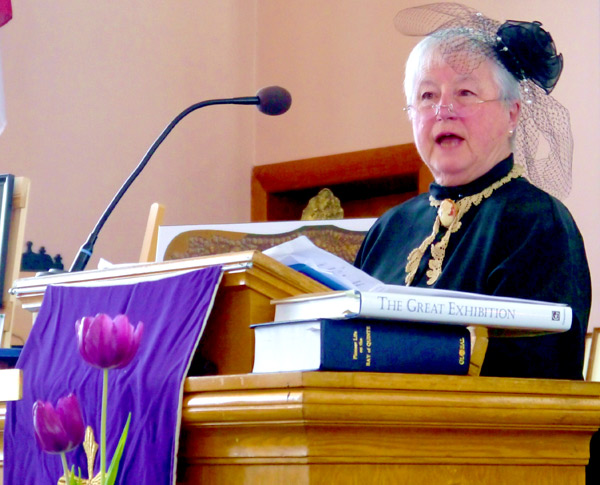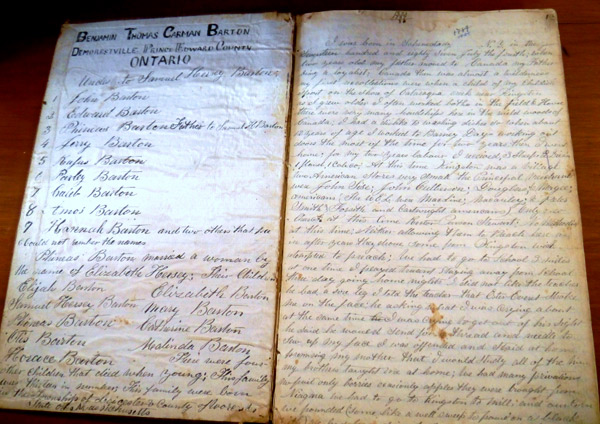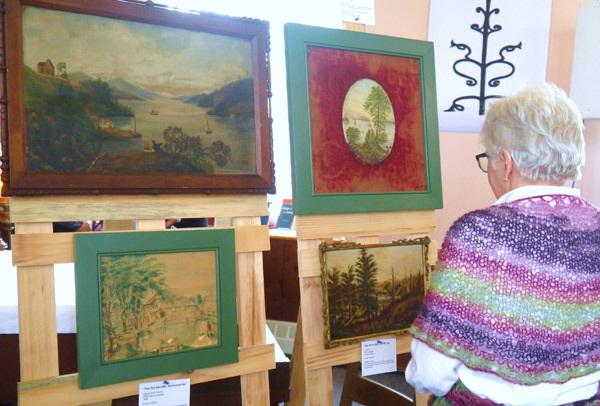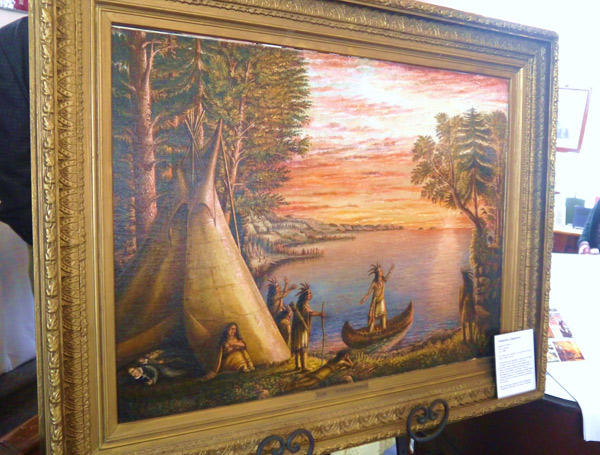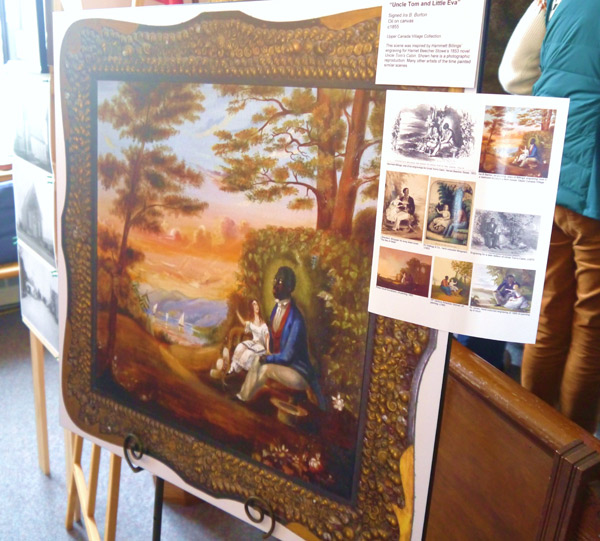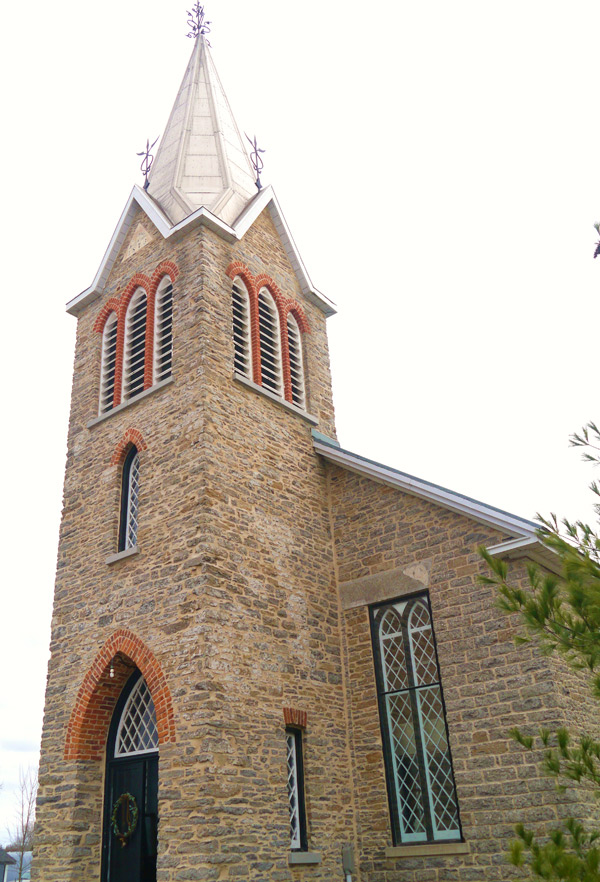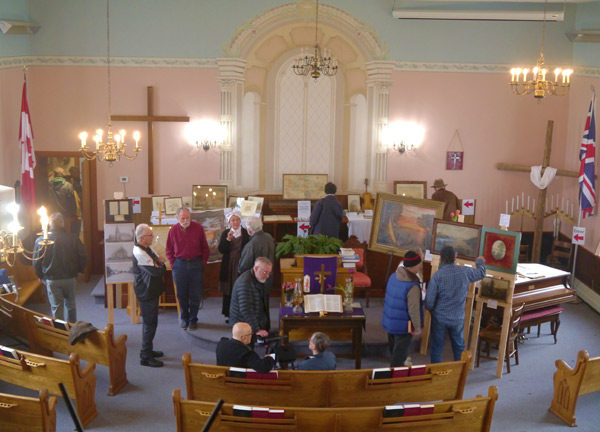Friendship and history shared at Demorestville church anniversary celebration
Administrator | Mar 18, 2024 | Comments 0
Story and photos by Sharon Harrison
“You can see that this enormous window looks three-dimensional, and as you come closer, you’ll see that it’s not; it’s completely flat, painted on a flat wall. Only an accomplished draughtsperson and painter can do this effect, and that was Thomas and Ira Barton.”
A weekend of celebration in Demorestville was also about stepping back in time 150 years to the year 1874, to learn about what was happening in this bustling place at the north end of the County, close to the shores of the Bay of Quinte.
For those drawn inside the familiar towering landmark on County Road 5 Saturday, the scene was set, the characters dressed and the stage prepared for sharing a some history with a full capacity room.
The year is 1874.
Part history lesson, part acting, part education and part comedy sketch, members and friends of the Friendship United Church delighted the crowd as they provided a glimpse into what was going on 150 years ago, especially as it pertained to a fresco painting many who’ve been inside the church have become familiar with over the years.
Painted on the inside back wall of the structure, it’s the first thing seen upon entering the building’s front door where it both blends in, and stands out, its apparent three-dimensional appearance a trick of the eye, but a pleasing one nonetheless.
The afternoon’s focus, however, was on County primitive painter Ira Barton, and the fresco he painted 150 years ago. The audience learned about the local chap with many talents, who was an astonishingly accomplished artist.
Along with Ira, the room was introduced to the Barton family: brothers Thomas and Stephen, as well as their sister Margaret; Pa (Samuel H. Barton) and Ma (Margaret Barton).
The special anniversary also recognized the significant changes to the church building completed a century-and-a-half ago.
“Today’s event honours the 150th anniversary of the massive renovation that happened in this church and included two of the most prominent features, which is the spire and the tower at the front at the entrance, and the addition of 12 feet to the other end of the building,” explained Conrad Biernacki, retired from the Royal Ontario Museum, and an Ira Barton enthusiast.
“As Patricia Taylor says in her 1971 book, ‘The History of the Churches of Prince Edward County’, it was said to be “the most commodious and neatly-finished church in Prince Edward County, outside of Picton”.
One of the other 1874 improvements to this church was the wall painting behind me, and it was created by brothers Thomas and Ira Barton, he said.
County resident Biernacki was introduced by the Reverend Barb Willard as “a man who has been instrumental in helping organize what you see in front of you”.
As the main character, Ira was joined by his siblings in a short skit, complete with period costume and props. He described the last days of getting the fresco completed in the humorous sketch and to great amusement of the audience.
Ira speaks to the paint not flowing properly due to the cold weather, and a cold church, and how it needed to be warmer as the mural needs to be finished.
“The circuit riders are coming tomorrow and we want the church at its best,” Ira says as the mural is finally completed.
“It looks just the way I wanted it to. It’s so beautiful, it’s made the room look 10-feet longer and it’s got windows,” expresses Ira. “I really wanted it to be so special, but will it last 150 years? I doubt that it will last that long, I worry that my art will soon be forgotten.”
“I wouldn’t worry Ira, it looks wonderful and I’m sure it will be here 150 years from now,” confirms Thomas. “Don’t even think that Ira, it’s destined to be one of the church’s best features, it will bring friendship we have here,” adds Stephen. “I say we bless this church, let’s go ring the bell to celebrate.”
Margaret Barton marvelled at the beautiful new church, “it looks so lovely, it looks so elegant and look at the mural, it really turned out well, fellas”, and she described how the day came to be, as well as sharing a little about her brothers.
“Ira planned and painted this magnificent mural up here. He’s an artist, as you can tell, he’s a musician, his fiddle is here, and he was a furniture maker, he even taught art lessons here in the village,” shared Margaret.
She said Stephen is a painter, and Thomas is a wainwright and a carriage maker, but he is also an artist and a painter, and helped a lot with the mural.
Ma and Pa came from New York state and had eight children, noting how she was named after Ma.
“Pa, Samuel H. Barton, was a hatter by trade, and when he got here, he became the township clerk, the tax collector, the assessor, the justice of the peace and the librarian, so he didn’t have much time to be making hats after he got here,“ Margaret says. “My brothers and I lived all our lives with Ma and Pa in the third house down the hill, the white one.”
Margaret goes on to describe how this day, that is now being celebrated, came to be.
“It was last May 1873, that the villagers had a meeting to repair and re-model the old stone church,’ explains Margaret. “On that day, they raised $378 to raise the roof, extend the front and put the steeple on the front. We wanted a grand edifice for our little village here.”
The business was completed on the church at the end of July, and on Aug. 1 the work began, where Margaret notes that many, many villagers came in and helped remove the pews and the lamps, and all the fixtures around to protect from the construction.
After just seven months, the job was complete: the stonework, raising the roof, extending the building.
Margaret notes it wasn’t easy as it was a harsh winter and they didn’t think the steeple would ever get done “in February no less with the faulty scaffolding and ice storm and all, and that big wind we had in December that tore off the six trees and threw down the fences and unroofed six sheds. Much as Stephen tired to get the windows fast, so they would be safe, they blew in, and all his work of putting in with the fine glass that we had cut went to pieces and had to be re-done”.
Margaret (aka Beverly Sprague) noted how she and Ira kept journals at the time, and which are now in the great care of the Marilyn Adams Genealogical Research Centre (MAGRC) in the County and available for the public to view (some of the originals were on display at the weekend event). MAGRC has reproduced the journals in 12 big binders to ensure the original diaries are not harmed.
This day is a tribute to all the families over the years that have worked hard to keep this old building a place for us to worship,” Sprague added.
Biernacki explained how celebrating the 150th anniversary of the window (mural) led to the investigation of the history of Demorestville for him, where he learned about the Barton family and what they were about, but particularly mural painter, Ira Barton, as he shared a little about what Ira painted and why, together with some fascinating back stories, interpretation and local history.
The collection of Ira Barton paintings on display at the weekend is the largest ever display of paintings and sketches by Ira Barton, according to Biernacki, borrowed from the County Museums, and from several private collectors.
“He painted his immediate world, he painted what he saw every day, and what he experienced every day,” Biernacki explained. “From his home in Demorestville, his world seemed to be no wider than Mosquito Bay (now Muscote Bay) in the west, and Long Reach in the east, that is the area that he painted in, mainly for a practical reason that to go somewhere, do a painting and come back in a day, you can only go so far.”
“But Ira’s world was far greater than that. His world was without limit because at his fingertips, he had books that inspired him to paint European scenes and to sketch sculpture, which he would never see, and also inspire him to draw many wild animals that do not exist in the County.”
It was explained how Ira likely didn’t own the books, but that they were probably borrowed from township library in Demorestville, or more than likely, the library in Picton.
“The day after Ira and Thomas finished this window, the mural behind me, Thomas writes in his diary, ‘Today, Ira is returning books to Picton’, so perhaps in one of those books, there were architectural drawings that inspired Thomas and Ira to do this window. We don’t know the exact source of it, but since books were so important to both of them to inspire their designs, that’s where we think it came from.”
In his talk, Biernacki spoke specifically to three of the paintings on display, including an 1868 oil painting, Hiawatha’s Departure, where he describes that the painting comes from a poem that Henry Wadsworth Longfellow wrote called The Song of Hiawartha.
“This poem, it is actually a book, it is a long, long, long poem and that’s actually what inspired many artists to think about and when this was first published it wasn’t illustrated, but certainly what Longfellow wrote fired the imagination of many artists.”
The next painting Biernacki spoke to in detail was an 1855 oil painting, Uncle Tom and Little Eva, the original of which has been displayed at Upper Canada Village since 1960. A photographic reproduction was made in its original size and frame for the occasion.
“Uncle Tom and Little Eva, as far as we know, is the only Ira Barton painting that was in a major art exhibition, and it was shown at the National Gallery in Ottawa and also at the Royal Ontario Museum, and at the Winnipeg Art Gallery.”
The third painting Biernacki addressed is Redner’s Store House, a watercolour by Ira Barton, where he explains how James Redner of Ameliasburgh owned and operated a grain storage and shipment facility on Mosquito Bay from 1862 to 1888.
“That location was chosen because it was near the east-west route across the top of the township and it is there in Mosquito Bay where he built his facility there, there happens to be a deep channel that goes out to the Bay of Quinte and so it was easy for the ships to go in and out,” he said. “You can imagine what a relatively efficient process that was to keep the grain up on top in the historic facility and then it would come down the shoot and drop into the schooners.”
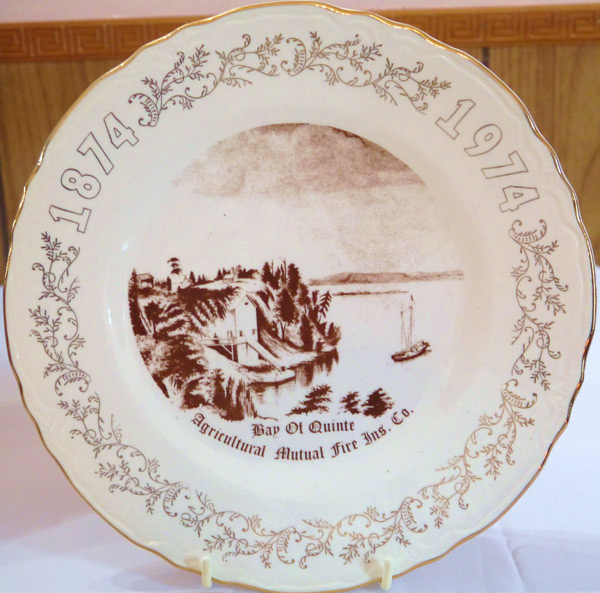 In 1974, Biernacki describes how the Bay of Quinte Agricultural Mutual Fire Insurance Company (now called the Bay of Quinte Mutual Insurance) commissioned the plate that copied Ira’s painting. It was produced by a china decorating firm in Collingwood, Ontario to celebrate the 100 anniversary in 1974 and was given to all its policy holders.
In 1974, Biernacki describes how the Bay of Quinte Agricultural Mutual Fire Insurance Company (now called the Bay of Quinte Mutual Insurance) commissioned the plate that copied Ira’s painting. It was produced by a china decorating firm in Collingwood, Ontario to celebrate the 100 anniversary in 1974 and was given to all its policy holders.
“It’s the only Ira Barton image ever produced on a plate and it was my curiousity about this plate that caused me to wonder where is the location because on the back it says it is a painting done by Ira Barton. Who was Ira Barton? I had no idea at that point.”
Biernacki’s personal journey of discovering exactly who Ira Barton was continued as he shared some local history of the area
Rev. Willard spoke to travelling back in time 150 years to the days of the Barton family, who were instrumental in the re-modelling of the church, “and in the creation of this masterpiece, this fresco”.
She also spoke to how in the 1870s, the church had a Methodist congregation, with many preachers serving congregations such as these were called saddlebag preachers or circuit riders.
“Because they travel on horseback along routes called circuits, and most of them on horseback had a saddlebag, and in that saddlebag would be all their worldly possessions, which obviously wasn’t much, and their bibles and their sermons,” said Willard.
“They would go along these routes, which would be quite long and arduous. visiting homes and settlements, preaching and doing any special service, like funerals, but they often had to rely on the hospitality of strangers for food and lodging.“
She said, some circuits took them as long as six weeks to complete, something she described as not an easy life, where they had to overcome all sorts of trials and obstacles.
“Needless to say, most were young men, and I read somewhere that they were mostly eccentric young men. A lot didn’t last long on the circuit, they died or succumbed to the dangers along the routes, or simply had had enough to give up.”
Visitors were encouraged to explore the church (upstairs too), enjoy the memorabilia and the artwork on display, engage with the costumed characters, and even ring the church bell if they wished. Lots of pie and cake were on offer as refreshments were served in the cafe afterward.
The weekend’s celebratory event concluded Sunday with a service to re-dedicate the mural.
Filed Under: Arts & Culture • Featured Articles • News from Everywhere Else
About the Author:



